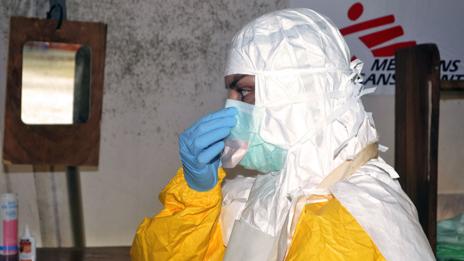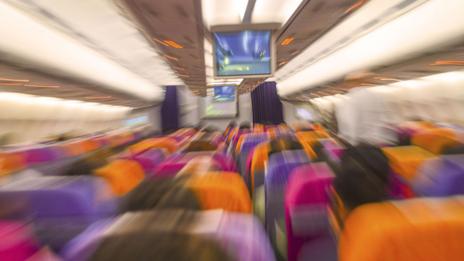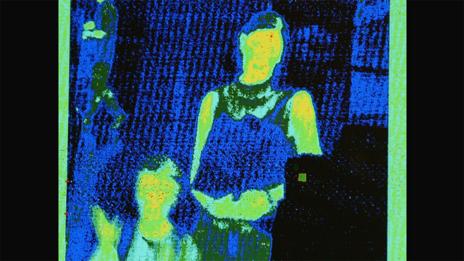Ebola: How easily do germs spread on planes?

(Science Photo Library)
The Ebola outbreak is stoking fears of a deadly virus spreading across
the world through air travel. We talked to experts to discover the risks
of catching the disease mid-flight.
Are plane cabins hotbeds of disease? Frequent flyers are often on
guard against sneezing or coughing co-passengers, in fear of catching
what they have. And the possibility that much more serious epidemics or
pandemics could spread by air travel has been a worry for years, whether
it is avian flu, Sars or tuberculosis.
Now we are in the middle
of one of the deadliest outbreaks of Ebola virus ever: the outbreak
started in Guinea last March and soon reached Liberia, Sierra Leone and
Nigeria. Concern in the West has heightened after it emerged that a man
had flown on internal flights while carrying the virus,
with fears growing that air travel could quickly carry the terrifying
disease around the world. British Prime Minister David Cameron described
Ebola as a “serious threat”.

How likely is it to catch a deadly disease mid-flight, and
what might stop a sick passenger carrying it between countries? To get a
sense of the risks involved, BBC Future talked to infectious disease
researchers to find out what we know about transmission during air
travel – and what this can tell us about the risk of Ebola spreading
across the world.
Transmission problems
The
risks of catching an infection from an ill passenger are not as high as
you would think, says Christine Pearson, a spokesperson for the Centers
for Disease Control and Prevention (CDC) in Atlanta, Georgia. “It’s not
any more dangerous than any place where you are in touch with lots of
people – like a shopping mall food court for example.
John Oxford,
a virologist at Queen Mary University, London, agrees. He points out
that the aeroplane ventilation goes from the ground to the ceiling,
where the air is filtered for bacteria and viruses before it
recirculates. Simulations looking at the potential spread of germs have
found that they are generally confined to just a couple of rows either side of the carrier.
Even then, the chances appear to be small, according to a study
published in the British Medical Journal. The paper looked at a flight
involving nine school children who were later found to be carrying the
swine flu virus. Just two other passengers, of more than 100 questioned,
later developed the illness – and they were both sitting within two
rows of the ill school kids. As a result, the researchers concluded that
there was just a 3.5% risk of catching the illness if you were sitting in those seats. A handful of other studies, looking at measles and TB,
also suggest that in-flight transmission rates are similarly low. From
studies such as these, Oxford says that “the biggest risk is not on the
plane, but in the taxi on the way to the airport”.
However, John
Edmunds, professor of infectious disease modelling at the London School
of Hygiene and Tropical Medicine, points out that it is difficult to
come to any firm conclusions, even for the more prevalent diseases. The
number of studies is small, he says, meaning you can’t find absolute
figures for the risk and compare that to the risk of infection in a
school, say. So it is even harder to assess the risk of in-flight
transmission of rare and unstudied diseases like Ebola.

Mode of transmission is clearly a factor. There are a few
documented cases of norovirus spreading among passengers – probably due
to people sharing the same toilet. But we know that Ebola is relatively
difficult to catch: unlike respiratory diseases like colds and flu, it
can only be transmitted through contact with bodily fluids like saliva,
vomit, or blood, which begins to secrete out of every orifice. Although
it is unlikely that someone suffering the full-blown attack would
attempt to fly, it is not impossible. Patrick Sawyer, a US citizen who
died from the virus last week, showed some of these symptoms on a flight
from Liberia to Nigeria, raising fears for the other passengers.
Airline staff and public health officials should be more aware of the
dangers now, however, and should place anyone suspected of having the
disease in quarantine. “Everyone is on the lookout,” says Oxford.
There
is always the chance that a passenger could board a flight before they
have developed the full-blown symptoms. But so far, the evidence
suggests you are unlikely to catch it from someone in the early stages
of the disease, before they have started vomiting and bleeding. “I
wouldn’t want to be a passenger next to a guy with Ebola,” admits
Edmunds. “But if they are just sitting there with a fever, I can’t
imagine the situation being high risk.” Oxford points out that basic
hygiene measures should further reduce the chance of infection – even if
it can’t eliminate the danger completely. “The Ebola virus is very
easily killed; you can kill it with hot water and soap,” he says.
“Alcohol rubs get rid of it in a microsecond.”
“Small risk”
If
an apparently healthy person carrying the virus lands in a country,
there is still room for a second stage of contagion. This is perhaps the
greater risk for a global epidemic – undetected carriers are the way
that swine flu and Sars spread across the world. “The history of the
spread of infectious diseases is infinitely entwined with improvements
in travel,” says Edmunds. He points out that in the past, the spread of
diseases was limited by the length of travel; measles develops quickly,
so all the cases would have burnt out by the end of a long voyage. Since
Ebola has an incubation period of up to 21 days, carriers could arrive
in a country weeks before symptoms develop – potentially transmitting it
to the people they know. “It is an issue,” admits Oxford, but he is
optimistic that the infection could still be contained. Anyone showing
the symptoms would have a rapid diagnosis before being quarantined, and
health authorities would also check anyone who had been in contact with
them – such as air crews, passport officials and their families. “All of
that can stop it spreading – and it will be stopped.”

A spokesperson for the World Health Organization, Gregory
Härtl, says its official stance currently is that a global epidemic is a
“small risk”, although it is currently working with the International
Air Transport Association to review their recommendations. Currently, it does not recommend screening passengers at airports
– since the thermal scanners used to detect a fever are unlikely to
find people incubating the first stages of the disease – and there are
no recommended travel restrictions.
However; the situation is
evolving fast and the recommendations may change in the coming days. At
the moment, no one can yet predict whether other air travellers have
been infected with the disease, but the hope is that heightened
vigilance will help to minimise any potential risk. However, even if it
is successfully contained and the outbreak peters out, Ebola shows, yet
again, the fact that no disaster or epidemic is too distant in the
highly-connected modern world.
If you would like to comment on this, or anything else you have seen on Future, head over to our Facebook or Google+ page, or message us on Twitter.
Disclaimer
All content within this column is provided for general information only, and should not be treated as a substitute for the medical advice of your own doctor or any other health care professional. The BBC is not responsible or liable for any diagnosis made by a user based on the content of this site. The BBC is not liable for the contents of any external internet sites listed, nor does it endorse any commercial product or service mentioned or advised on any of the sites. Always consult your own GP if you're in any way concerned about your health
All content within this column is provided for general information only, and should not be treated as a substitute for the medical advice of your own doctor or any other health care professional. The BBC is not responsible or liable for any diagnosis made by a user based on the content of this site. The BBC is not liable for the contents of any external internet sites listed, nor does it endorse any commercial product or service mentioned or advised on any of the sites. Always consult your own GP if you're in any way concerned about your health










0 comments:
Post a Comment